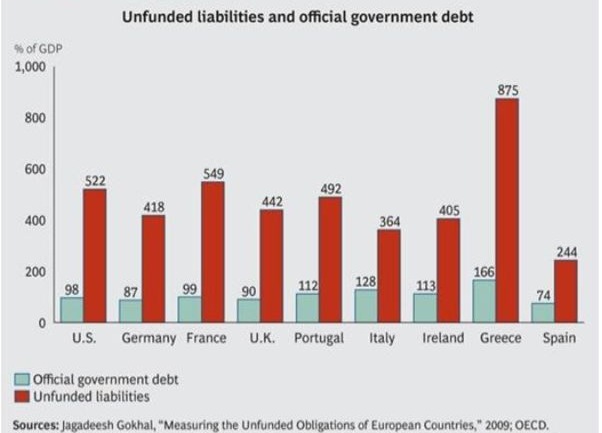
These economies are saturated with debt, having managed to accumulate more than 200 percent of their GDP in total public and private debt. This amount exceeds 300 percent of the GDP for most of the European economies while Japan and the UK have surpassed the 500 percent level (IMF, McKinsey Global Institute).
If we focus on the public debt only, the picture is equally worrisome, with countries like the UK, France or Spain having already topped the 90 percent threshold level. However, this government debt is tiny compared to the amount represented by Unfunded Liabilities, the promises of pensions and health care made for future generations.
Our healthcare systems are obsolete . They were designed when a large proportion of health concerns and expenditure was devoted to acute conditions. Today the problem is different. The changing demographic context is shifting the burden of disease from acute to chronic conditions. Patients with at least one chronic condition represent 85 percent of healthcare utilization in the US while in the UK they imply 80 percent of primary care consultations and 66 percent of emergency hospital admissions.According to the World Health Organization (WHO), most of the illnesses and death related to chronic diseases are closely linked to four risky behaviours:
- Lack of physical activity
- Poor nutrition
- Tobacco use
- Excessive alcohol consumption
The good news as that recent evidence shows that there is scope to improve: a recent report from the Institute of Medicine (an independent, not-for profit organization that is part of the National Academy of Sciences) on the state of the US healthcare sector found that about thirty percent of the money committed to healthcare was not used in the best possible way . When looking at potential cost reductions for 7 hospital intervention in OECD countries, the author reached a number between 20 to 30 percent (Erlandsen, 2007).
This data already tells us that the financial pressures on healthcare are not only the result of the current economic, but they are structural , and we know that structural problems require structural changes. It’s time to start rethinking our health systems with a “Triple Aim” goal in mind :
- Improve the health status of the population
- Contain healthcare costs
- Improve patient’s involvement and experience of care



